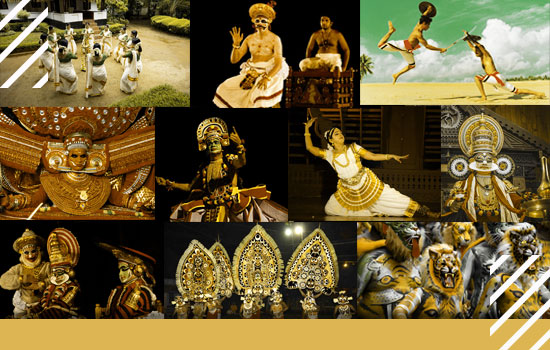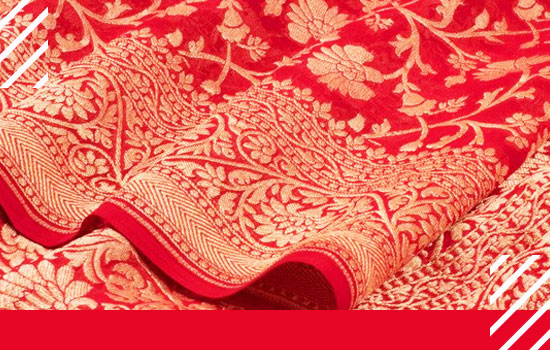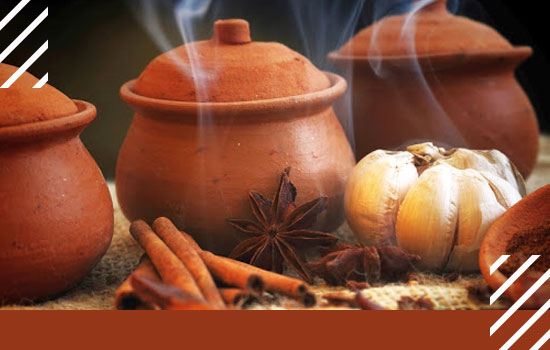Referred to as “God’s Own Country”, the state of Kerala has given birth to a plethora of traditional arts and cultural forms.
Its breathtaking beauty has been holding on to people’s hearts from all around the world for ages.
Be it the mesmerizing backwaters or captivating beaches; the amazing ritual arts or mouth watering cuisine; the scenic perfection or the Eco-friendly environment, Kerala never fails to amaze its tourists and has everything to entertain them.
Also known to be the land of festivals, Kerala has evolved and flourished in different categories, one being the rich artistic heritage.
From the pleasing forms of performing arts to the fascinating forms of folk art, the state has birthed and nurtured a world of exquisite beauty.
Let’s have a look at what makes Kerala a must-visit place for all those with a fondness for art and culture!
Recommended Story – Koftgari; The Art of Royal Weaponry
Kathakali- A Classical Indian Dance Form
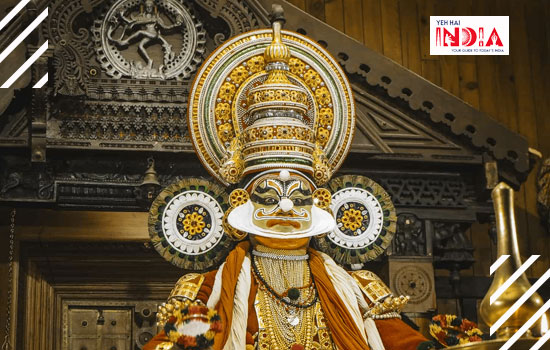
A marvellous form of classical performing art, Kathakali is a perfect feast for the eyes and an exposure to entertainment.
It is undoubtedly the symbol of Kerala’s enticing art heritage which is based on the use of ‘Mudras’, meaning the hand and palm mode of expressions.
Kathakali is an elegant mix of vibrant makeup, facial expressions, colourful costumes, anecdotes from Indian epics, and the synchronicity of music with the gestures of the performers.
One amongst the profound icons of Kerala, the dance form of Kathakali originated over 400 years ago and is now admired by visitors from across the world.
Mohiniyattam- Story-Telling Through the Art of Physical Expression
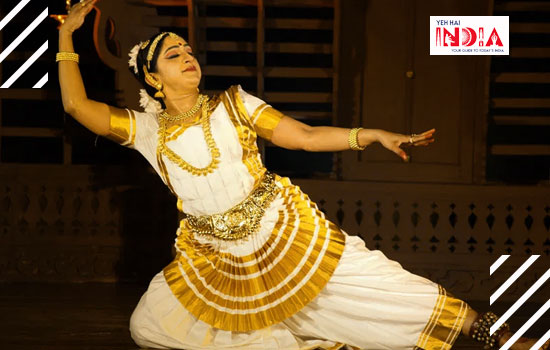
A lot like Kathakali, Mohiniyattam also involves the coordination of precise hand gestures, facial expressions and body movements to put forward a story in front of the audience.
This delightful dance form is performed by women draped in a white saree with golden borders which represents the usual dressing style of women in Kerala.
The word ‘Mohini’ refers to the mythical character of Hindu Lord Vishnu, who is believed to have incarnated as ‘Mohini’ to seduce the demons during the ‘Samudra Manthan’ or ‘Churning of the Milk Ocean’.
In comparison with the other art forms of Kerala, Mohiniyattam involves a very subtle and simple style of makeup and costume.
The musical element of Mohiniyattam is performed in ‘Manipravalam’, a linguistic mix of Sanskrit and Malayalam adding to the charm of this rich art form.
Theyyam- A Unique Combination of Dance, Music, and Mime

Theyyam is a peculiar and vivid dance form that reflects the ancient tribal culture of Kerala. This ritual art form is celebrated to worship the Hindu Goddess ‘Kaali’.
The ancient tradition of performing Thayyam dates back to almost 1500 years with North Malabar being its centre.
The dance is presented by men dressed in vibrant costumes and wearing meticulous makeup representing the deity.
It is assumed that the spirit of the deity is passed on to the performing artist as soon as he takes the get up of Thayyam.
The artist then runs and dances around the shrines, graveyards, ancestral houses, and courtyards to shower the blessings.
He also throws rice and turmeric powder on the audience as a symbol of blessing.
Thayyam being the most mythical and unique ritual art of Kerala, is an absolute source of entertainment for the audience.
Kutiyattam- The Oldest Existing Theatre Art of the World

Marking its history back to around 2000 years, the performing art of Kutiyattam is the oldest existing theatre art form in the world.
It is also the only surviving theatrical art based on ancient Sanskrit and has been recognized by UNESCO as a masterpiece of the oral and intangible heritage of humanity for its rich heritage and uniqueness.
The drama is performed by a group of people where the lead role is of Chakyar, the female role is Nangiars, and the role of a comic character is Vidushaka.
Quite similar to Kathakali, Kutiyattam also has its actors wear vibrant costumes and makeup which is very time consuming but the beauty you get to see is worth the time.
Every expression and body movements depict the emotions of the character being played by the artist.
Overall, Kutiyattam is a must-attend art when in Kerala.
Recommended Story – Amounee – The voice of artisans
Padayani- The Celebration of Goddess Kali’s Victory
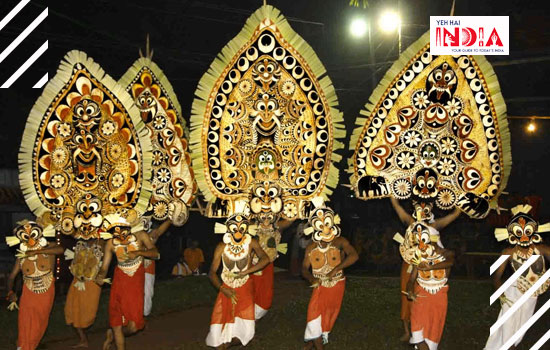
Celebrated in the temples of Goddess Bhadrakali, Padayani is a beautiful ritual art form of Kerala.
It is a traditional dance form that narrates the story of Goddess Kali’s victory after annihilating the demon named Darika.
The artists wear colourful attires and dance according to their characters.
The main highlight of Padayani is the big and vibrant leaf-made masks which represent the divine characters and spiritual forces.
Apart from the victorious celebration, Padayani is also performed to thank the Goddess for harvest.
With the variety of Kolam and the beats of the drums, Padayani is an absolute feast to the eyes.
Pulikali- The Iconic Street Art of Kerala
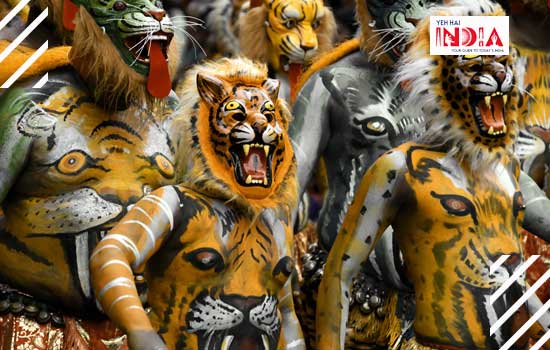
Pulikali is the annual street art and dance form which is celebrated during the harvest festival of Kerala, Onam.
The origin of this art dates back to 200 years.
The then ruler of Cochin, Maharaja Sakthan Thampuran introduced the folk art of Pulikali to celebrate Onam with a dance that reflected the wild spirit; that is how the role-play of the tiger emerged.
Offering thrill and excitement, the artists of Pulikali take the get up of the tiger.
They paint themselves with stripes of yellow, black and red, wear head masks, tie bells around their waists and dance wildly to the music.
Pulikali is majorly celebrated and performed in the city of Thrissur which has now become worldwide famous for the vibrant aura of this art.
Chakyar Koothu- A Unique and Venerable Form of Theatre Art
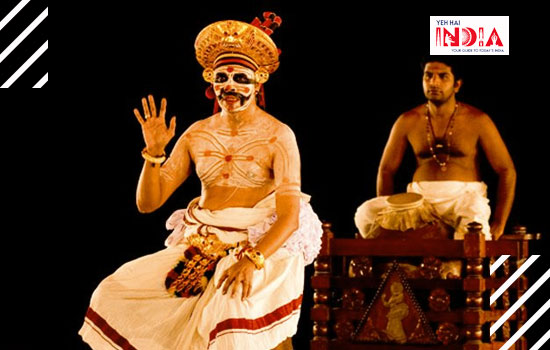
Initially performed only by the Chakyar community, Chakyar Koothu is one of the oldest forms of theatrical art in Kerala.
The art form represents various contemporary events and mythical stories of India through its satirical and humorous elements.
Like many other art forms of Keralite art heritage, Chakyar Koothu also has a very big role of expressions, gestures, signs and symbols in it.
The lead role is the character of Chakyar who satirizes and tells jokes to represent the epics and anecdotes with the essence of storytelling and the motive of entertaining audiences.’
Apart from its unique narrating style, the involvement of percussion instruments like mizhavu and elathalam has been drawing audience attention from all around the world.
Kalaripayattu- Mother of All Martial Arts

Known as ‘The mother of all martial-arts’, Kalaripayattu is considered to be the oldest existing form of martial art.
The defensive art form of Kalaripayattu originated in Kerala around three centuries ago and has crossed generations maintaining the same beauty.
The art uses a vast range of weaponry including knives, sword, urumi, and shield.
Kalaripayattu is believed to be the root of popular martial arts like Kungfu.
Apart from encompassing several disciplines like yoga and healing, Kalaripayattu has also contributed too many traditional art forms like Kathakali and Thayyam.
The quick and flexible body movements, extreme focus, and discipline involved in the art are both an inspiring scene for the viewers and a self-improvement exercise for the artists.
Ottamthullal – Poor Man’s Kathakali
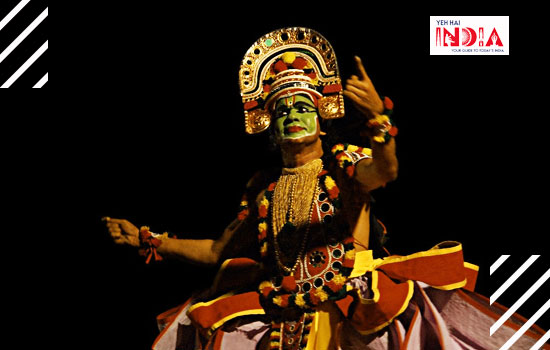
The perfect combination of humour, wit, and entertainment, Ottamthullal has a very interesting story behind its origin.
During a performance of Chakyar Koothu, Kunjan Nambiar had fallen asleep and was ridiculed by the Chakyar.
In return for the mockery, Nambiar decided to create the art form of Ottamthullal.
The art attempts to represent the political and socially relevant topics. Unlike other performing art forms, Ottamthullal is performed by only one artist.
What makes it different from other vivid dance forms like Kutiyattam and Kathakali is the fact that it can be understood easily as the language is simple along with the expressions, vibrant makeup, and dress-up.
The excellent combination of music, dance and light-heated humour makes the art of Ottamthullal stand out amongst others in a special way.
Thiruvathirakali- Graceful Dance Form Performed by Women

An elegant form of art, Thiruvathirakali is a dance performed by women mostly during Onam and doesn’t require any prior training or experience.
The women get dressed up in the Keralite attire of traditional Kasavu saree, wear gold jewellery and design their hairstyle with jasmine flowers.
Unlike all other art forms, Thiruvthirakali is a very simple and graceful dance form that can be learnt and celebrated by anybody.
The performance of Thiruvathirakali involves dancing in circular movements in simple lyrical steps, rhythmic clapping, and swaying movements.
The art forms of Kerala are indeed very vibrant and efficiently express the diversity and rich artistic heritage of the state in an exceptional way.
Exploring the artsy world of Kerala brings you closer to the Indian mythology and culture!
Also Read – 8 Books on Indian Art for Every Art Lover


